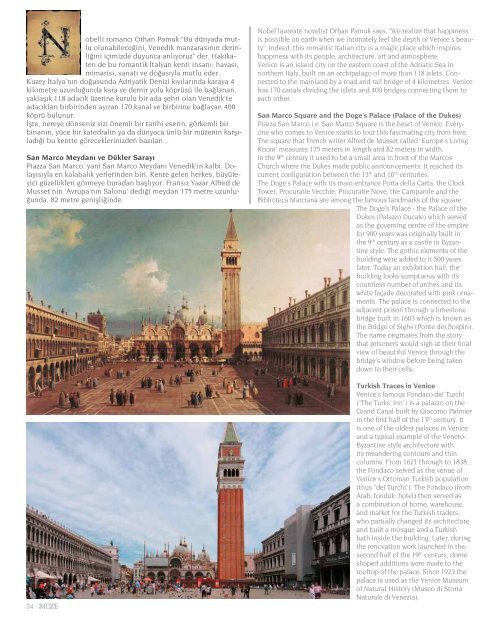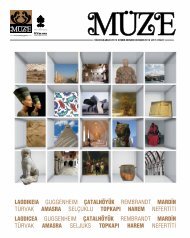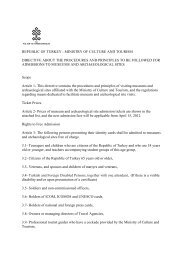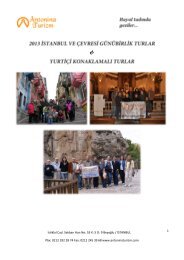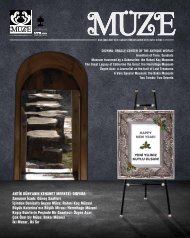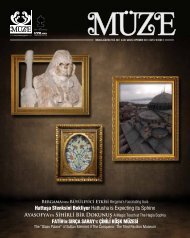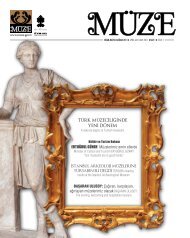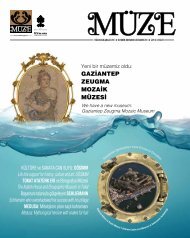obelli romancı Orhan Pamuk “Bu dünyada mutluolunabileceğini, Venedik manzarasının derinliğiniiçimizde duyunca anlıyoruz” der. Hakikatende bu romantik İtalyan kenti insanı; havası,mimarisi, sanatı ve doğasıyla mutlu eder.Kuzey İtalya’nın doğusunda Adriyatik Denizi kıyılarında karaya 4kilometre uzunluğunda kara ve demir yolu köprüsü ile bağlanan,yaklaşık 118 adacık üzerine kurulu bir ada şehri olan Venedik’teadacıkları birbirinden ayıran 170 kanal ve birbirine bağlayan 400köprü bulunur.İşte, nereye dönseniz sizi önemli bir tarihi eserin, görkemli birbinanın, yüce bir katedralin ya da dünyaca ünlü bir müzenin karşıladığıbu kentte göreceklerinizden bazıları...San Marco Meydanı ve Dükler SarayıPiazza San Marco, yani San Marco Meydanı Venedik’in kalbi. Dolayısıylaen kalabalık yerlerinden biri. Kente gelen herkes, büyüleyicigüzellikleri görmeye buradan başlıyor. Fransız Yazar Alfred deMusset’nin ‘Avrupa’nın Salonu’ dediği meydan 175 metre uzunluğunda,82 metre genişliğinde.34Nobel laureate novelist Orhan Pamuk says, “We realize that happinessis possible on earth when we intimately feel the depth of Venice’s beauty”.Indeed, this romantic Italian city is a magic place which inspireshappiness with its people, architecture, art and atmosphere.Venice is an island city on the eastern coast of the Adriatic Sea innorthern Italy, built on an archipelago of more than 118 islets. Connectedto the mainland by a road and rail bridge of 4 kilometres, Venicehas 170 canals dividing the islets and 400 bridges connecting them toeach other.San Marco Square and the Doge’s Palace (Palace of the Dukes)Piazza San Marco i.e. San Marco Square is the heart of Venice. Everyonewho comes to Venice starts to tour this fascinating city from here.The square that French writer Alfred de Musset called ‘Europe’s LivingRoom’ measures 175 meters in length and 82 meters in width.In the 9 th century it used to be a small area in front of the MarcosChurch where the Dukes made public announcements. It reached itscurrent configuration between the 13 th and 16 th centuries.The Doge’s Palace with its main entrance Porta della Carta, the ClockTower, Procuratie Vecchie, Procuratie Nove, the Campanile and theBiblioteca Marciana are among the famous landmarks of the square.The Doge’s Palace - the Palace of theDukes (Palazzo Ducale) which servedas the governing centre of the empirefor 900 years was originally built inthe 9 th century as a castle in Byzantinestyle. The gothic elements of thebuilding were added to it 500 yearslater. Today an exhibition hall, thebuilding looks sumptuous with itscountless number of arches and itswhite façade decorated with pink ornaments.The palace is connected to theadjacent prison through a limestonebridge built in 1603 which is known asthe Bridge of Sighs (Ponte dei Sospiri).The name originates from the storythat prisoners would sigh at their finalview of beautiful Venice through thebridge’s window before being takendown to their cells.Turkish Traces in VeniceVenice’s famous Fondaco dei Turchi(“The Turks’ Inn”) is a palazzo on theGrand Canal built by Giacomo Palmierin the first half of the 13 th century. Itis one of the oldest palaces in Veniceand a typical example of the Veneto-Byzantine style architecture withits meandering contours and thincolumns. From 1621 through to 1838,the Fondaco served as the venue ofVenice’s Ottoman Turkish population(thus “dei Turchi”). The Fondaco (fromArab: fonduk: hotel) then served asa combination of home, warehouse,and market for the Turkish traders,who partially changed its architectureand built a mosque and a Turkishbath inside the building. Later, duringthe renovation work launched in thesecond half of the 19 th century, domeshaped additions were made to therooftop of the palace. Since 1923 thepalace is used as the Venice Museumof Natural History (Museo di StoriaNaturale di Venezia).
Meydanın geçmişi 9. yüzyıla dayanıyor.O zamanlar meydan düklerinaldıkları kararları açıkladıkları,Markus Kilisesi’nin önündeki küçükbir alanmış. Bugünkü konumuna 13.ve 16. yüzyıllar arasındaki çalışmalarsonucunda ulaşmış.Büyük Kanal’dan başlandığında, meydandasırasıyla şu binalar yer alıyor:Dükler Sarayı, Porta della Carta, SaatKulesi, Procuratie Vecchie, ProcuratieNove, Campanile ve Biblioteca Marciana.Güvercinlerle dolu meydanda dörtbir yanınız muazzam binalarla çevrili.Bunlardan biri de Dükler Sarayı(Plazza Ducale). 900 yıl boyuncaimparatorluğun merkezi olan saray,9. yüzyılda Bizans tarzında bir şatoolarak inşa edilmiş ancak şatoya500 yıl sonra gotik ögeler eklenmiş.Dışı beyaz ve açık pembe bezemelerlesüslü, bol kemerli ve oldukçaihtişamlı olan bu yapı günümüzdesergi alanı olarak kullanılıyor. Saray,1603 yılında taş bir köprüyle hemenyanındaki hapishaneye bağlanmış.İtalyanlar bu pencereli köprüye ‘Sonnefes (Sospiri) köprüsü’ diyor, çünküidam mahkumları dünyayı son kez bupencerelerden görüyormuş.Venedik’te Türk izleriVenedik Doğa Tarihi Müzesi olarakkullanılan ünlü Fondaco dei Turchi13. yüzyılın ilk yarısında GiacomoPalmier tarafından inşa edilmiş birsaray. Venedik’in en eski saraylarındanbirisi olan Fontego dei Turchikıvrımlı bağlantıları ve ince sütunlarıile Bizans Dönemi mimarisinin tipikbir örneği. 1621’den itibaren Türktüccarlar sarayı ticaret merkezi olarakkullanmaya başlamış. 1838’e kadarolan bu süreçte orada ikamet edenTürkler binaya bir cami ve hamaminşa etmişler ve sarayın mimarisinikısmen değiştirmişler. Ayrıca 19. yüzyılınikinci yarısında başlayan restorasyonçalışmaları esnasında sarayınüst kısmına kubbe biçimde eklemeleryapılmış. Saray 1923’den beri VenedikDoğa Tarihi Müzesi (Museo di StoriaNaturale di Venezia) olarak kullanılıyor.Canaletto’nun 1730’da yaptığı San Marcomeydanı tablosu, meydanın bugünkügörünümü (sol sayfa), Leonardo da Vinci’ninVitruvius Adamı (üstte), Carpaccio’nunGalleria dell’Accademia’da sergilenen ‘TheHealing of the Madman’ tablosu (ortada) veSan Marco Bazilikası’nın ön cephe detayı.San Marco Square painting (1730) byCanaletto and present-day view of the square(left page), Leonardo da Vinci’s VitruvianMan (above), Carpaccio’s ‘The Healing of theMadman’ painting exhibited at the Galleriadell’Accademia (centre) and St. Mark Basilica’sfaçade detail.Thousands of famous paintingsAmong the most visited places in Veniceis the Galleria dell’Accademia which hasthe most beautiful collection of Venetianart. Its collection comprises canvasespainted between the 14 th and 18 th centuries.The artworks are exhibited in 24halls in a chronological order. World-famousworks of world-famous artists, the‘Crucifixion of Ten Thousand Martyrs’ byCarpaccio, Mantegna’s ‘St. George’, Giorgione’s‘Portrait of an Elderly Woman’,Paolo Veronese’s ‘The Feast in theHouse of Levi’ and Tiziano’s Pietà awaitvisitors here. The famous ‘Vitruvian Man’drawing created by Leonardo da Vinci in1490, various canvases of Gentile Bellini,the painter who was sent to Istanbul in1479 by the Republic of Venice and whopresumably painted Sultan Mehmet theConqueror’s portrait (currently at theNational Gallery in London); as wellas Giovanni Battista Tiepolo’s Neptunepainting; three of the St Mark paintingsby Jacopo Comin, known as Tintoretto,‘St Mark’s Body Brought to Venice’, ‘StMark Rescuing a Saracen from Shipwreck’and ‘Miracle of the Slave’ are ondisplay here. (The fourth painting of theseries ‘Finding of the body of St Mark’is now held in the Pinacoteca di Brera inMilan.)Basilica of San Marco akathe Golden ChurchThe San Marco Basilica at Piazza SanMarco, one of the best known examplesof Byzantine architecture originallybuilt as the chapel of the rulers ofVenice was completed in 1617. Used asthe residence of the Patriarch of Venicesince 1807, the building’s interiordesign is known for its opulence. It hasbeen adorned with quite spectaculardecorations to illustrate and demonstratethe power of Venice. Since realgold chips were used in its mosaics theedifice is also known under the nameof ‘Chiesa d’Oro’, the Golden Church.An area of approximately 4 thousandsquare metres of the church is coveredwith mosaics depicting scenes from theBible. On the other hand, the acousticconfiguration of this church contributedto the stylistic development of Baroquemusic. It is one of the finest examples ofRomanesque church architecture. The 4bronze horses placed at the centre of thebalcony called ‘Horses lodge ‘facing thesquare, are exact replicas of the TriumphalQuadriga or Horses of Saint Markfrom the Classical Antiquity which wereinstalled on the basilica in about 1254.They were brought to Venice as part ofthe loot sacked from Constantinople inthe Fourth Crusade. The originals thatunderwent a long restoration are kept inSt Mark’s Museum (inside the basilica)35


